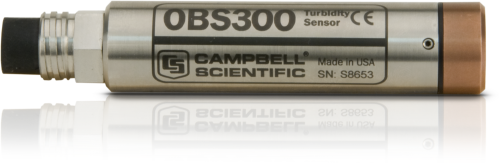This product is no longer available and has been replaced by: ClariVue 10. Some accessories, replacement parts, or services may still be available.

| Services Available | |
|---|---|
| Repair | Yes |
| Free Support | Yes |
Overview
The OBS300 is a submersible turbidity probe that has downward-facing optics. It uses OBS® technology to measure suspended solids and turbidity for applications ranging from water quality in freshwater rivers and streams to sediment transport and dredge monitoring. Campbell Scientific dataloggers measure the OBS300 probe's output and calculate turbidity.
Read MoreBenefits and Features
- Downward-facing optics avoid obstructions around the sides of the probe
- Measures suspended solids and turbidity for up to 4000 NTUs
- Provides a compact, low-power probe that is field proven
- Stainless-steel body allows use down to 500 m in fresh water
- Compatible with most Campbell Scientific data loggers
- Titanium body allows use down to 1500 m in fresh or salt water
- Accurate and rugged
- Fitted with MCBH-5-FS, wet-pluggable connector—multiple mating cable length options available
- Offers an optional five-point sedimentation calibration for better measurements (see Ordering Info on the web page)
Images




Technical Description
The OBS300 uses its downward-facing optics to emit a near-infrared light into the water. It then measures the light that bounces back from the water’s suspended particles.
If an obstruction is in the emitted light’s range, the light will scatter back and the turbidity reading will be too high. This probe's downward-facing optics avoid obstructions around the sides of the probe. The OBS-3+ is available for locations that have obstructions above and below the probe. (OBS® is a registered trademark of Campbell Scientific.)
Compatibility
Please note: The following shows notable compatibility information. It is not a comprehensive list of all compatible products.
Dataloggers
| Product | Compatible | Note |
|---|---|---|
| 21X (retired) | ||
| CR10 (retired) | ||
| CR1000 (retired) | ||
| CR10X (retired) | ||
| CR200X (retired) | ||
| CR211X (retired) | ||
| CR216X (retired) | ||
| CR23X (retired) | ||
| CR300 (retired) | ||
| CR3000 (retired) | ||
| CR310 | ||
| CR500 (retired) | ||
| CR5000 (retired) | ||
| CR510 (retired) | ||
| CR6 | ||
| CR800 (retired) | ||
| CR800 (retired) | ||
| CR850 (retired) | ||
| CR850 (retired) | ||
| CR850 (retired) | ||
| CR850 (retired) | ||
| CR9000 (retired) | ||
| CR9000X (retired) |
Specifications
| Range |
|
| Maximum Submersion Depth |
|
| Maximum Concentration Range |
|
| Concentration Accuracy |
|
| Operating Temperature Range | 0° to 40°C |
| Drift over Time | < 2% per year |
| Maximum Data Rate | 10 Hz |
| Minimum Warm-up Time | 2 s |
| Infrared Wavelength | 850 nm ±5 nm |
| Daylight Rejection | -28 dB (re: 48 mW/cm-2) |
| Optical Power | 2000 µW |
| Turbidity Accuracy | 2% of reading or 0.5 NTU (whichever is larger) |
| Housing Material | 316 stainless steel or titanium |
| Connector | MCBH-5-FS, wet-pluggable |
| Diameter | 2.5 cm (0.98 in.) |
| Height | 13.1 cm (5.15 in.) |
| Weight | 181.4 g (0.4 lb) |
-2.5 Output Option |
|
| Output Voltage | 0 to 2.5 V (over selected NTU range) |
| Supply Voltage | 5 to 15 Vdc |
| Current Drain | 15 mA |
-5 Output Option |
|
| Output Voltage | 0 to 5 V (over selected NTU range) |
| Supply Voltage | 5 to 15 Vdc |
| Current Drain | 15 mA |
-20 Output Option |
|
| Output Voltage | 4 to 20 mA (over selected NTU range) |
| Supply Voltage | 9 to 15 Vdc |
| Current Drain | 45 mA |
Related Documents
Product Brochures
Technical Papers
- OBS and Turbidity Sensors Basics (2Q-P)
- OBS: Effects of Light Absorption and Scattering in Water Samples on Measurements
- OBS Sensors: Light Sources and Photodetectors
- OBS: Effects of Suspended Solids Concentration (SSC)
- OBS Measurements: Effects of Sediment Size
- OBS Measurements: Effects of Sediment Color
- OBS Measurements: Effects of Water Color
- OBS: Effects of Bubbles
- OBS Sensor: Effects of Fouling on the Lens
- OBS Sensors: Sediment Calibration
- OBS Sensors: Turbidity Calibration
- OBS: Comparison of Suspended Solids Concentration (SSC) and Turbidity
Related FAQs
Number of FAQs related to OBS300: 2
-
No. A datalogger is necessary.
-
This depends on the turbidity of the water. In very clear water exposed to direct sunlight, up to 18 in. of water may be needed to prevent the sun from affecting the readings. Less sunlight penetrates more turbid water, which means the sensor would not need to be positioned as deeply. If the target water is clear and shallow, it may be necessary to construct a canopy above the water to shadow the monitoring site.
In addition, the sensor must be positioned in the water so that nothing obstructs its field of view. In very clear water, this may require an 18 in. standoff.